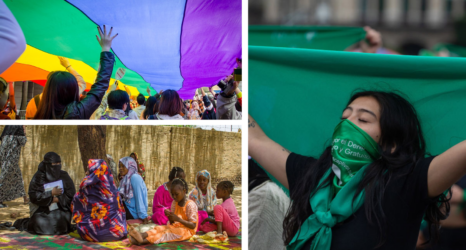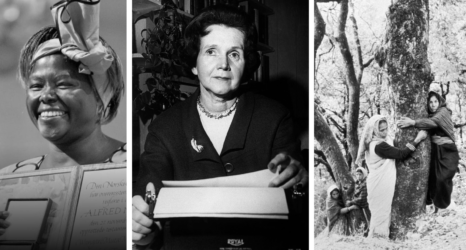Fifteen years ago, Bangladesh was fast becoming a star in the eyes of the United Nations. The poor, hyper-populated Southeast Asian country was poised to meet—even surpass—the United Nations’ Millennium Development Goals, serving as a model to the rest of the world that with the right investments, poverty could be eradicated. A booming ready-made export garment industry was generating 80 percent of total exports and millions of women, the backbone of the industry, now had access to steady employment. But the absence of a justice system has turned opportunity into a dangerous compromise.
Billions of foreign dollars in exports initially paved the way for more development in garment export facilities, and ever-more cheap and fashionable garments for big box retailers around the world. Factory fires and collapses were viewed as one-time mishaps; new factories were built over their ashes. By the early 2000s, however, disasters struck with terrifying frequency. In 2005, a building collapse at the Spectrum sweater factory killed 64 workers, and was swept under the rug. A series of smaller yet deadly incidents followed, until a November 2012 fire engulfed the Tazreen Fashions building in Dhaka stunned the world, if only for a moment.
One survivor of the Tazreen disaster, Sumi Abedin, was forced to jump from a third-story window when she discovered that all the exits had been locked from the outside. She knew her body was worth at least $1,000 in compensation, a valuable asset for any low-income family, so her first thought was to “jump to save my body, not to save my life.” One hundred and twelve of her co-workers died in the building that night, most burned alive, most of them women. The story broke international headlines. Sweatshops. Abusive managers. Child workers. Exploited women. The development star was flaming out.
Labor activist Kalpona Akter said, “It’s only a matter of time” before it happens again. And she was right: factory disaster was systemic. Five months after the Tazreen fire, Rana Plaza collapsed, taking more than 1,100 lives with it, the most egregious and unnecessary tragedy in garment industry history. Tags for a host of well-known Western brands were found among the bodies and rubble.
What was the international response? Labor groups rallied on the streets of major cities and on university campuses; designers, performance artists and cultural icons took action to demand transparency in supply chains; and some consumers staged boycotts. In the following months, dozens of fast fashion companies signed onto independent monitoring bodies that inspect physical structures and provide vital support for factory workers. Finally, this past week, the International Labor Organization was able to reach its $30 million dollar goal for the Rana Plaza victims’ compensation fund.
By comparison, the response inside Bangladesh has been lackluster. A lot of hand-wringing, no justice. In fact, Bangladesh has never prosecuted a garment factory owner for negligence or wrong-doing relating to factory management. While factory workers must endure a culture of fear, there is impunity for the ownership elite. It’s an open secret that inspectors are bribed to overlook abuses, or not inspect a building at all. Not long after Rana Plaza fell, it was business as usual and garment industry exports grew once more.
Tazreen Fashions owner Delwar Hossain spent fewer than six months in pre-trial detention before he was granted freedom on the condition that he pay outstanding wages owed to about 1,600 of his employees—many of whom were on hunger strike. He’s currently living as a “free” man in Dhaka and has applied for $3.87 million in soft loans from the Bangladesh Garment Manufacturers Export Association (BG-MEA) to reopen his factories.
Sohel Rana, the owner and manager of Rana Plaza, was a known political thug before his factory building collapsed. He built the complex on shoddily packed wetland and then added three illegal stories to the top of the structure, packing them with heavy machinery. When cracks appeared in the building’s support beams, he flouted requests to shut down. Fortunately, he was captured in the days after the collapse as he attempted to flee across the Indian border.
Last month, Rana and 41 others connected to the Rana Plaza collapse were charged with murder. Authorities have said that they wanted to indict Rana a year ago, but were unable to because of trouble in the courts. There were reportedly at least a dozen government officials under investigation because of their direct ties to the tragedy. They are amongst the group now standing trial.
This is a big moment for Bangladesh to provide justice for those who depend on garment jobs to find their way out of abject poverty. The government is in debt to the women and men who give their lives to generate the income that makes the elite rich: they owe them rights to protection. The overriding challenge in Bangladesh is that the garment industry owners are also operating parts of the government. In a country run by garment barons, for garment barons, there’s a conflict of interest when it comes to accountability—it cuts into their bottom line.
The fate of Sohel Rana is not yet sealed—a hearing is scheduled for June 28. But he cannot be scapegoated for the failings of an industry abetted by feckless governance. In order to sustain the growth it has achieved and actually provide for its citizenry—to become a true development star—Bangladesh will have to clean up its act from top to bottom. A precedent must be set that willful negligence and corruption will not be tolerated. That at the end of the day, justice is good business.
Photo courtesy of Flickr user Solidarity Center licensed under Creative Commons 2.0





